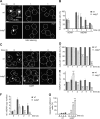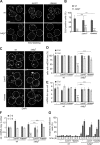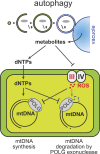Autophagy balances mtDNA synthesis and degradation by DNA polymerase POLG during starvation
- PMID: 29519802
- PMCID: PMC5940314
- DOI: 10.1083/jcb.201801168
Autophagy balances mtDNA synthesis and degradation by DNA polymerase POLG during starvation
Abstract
Mitochondria contain tens to thousands of copies of their own genome (mitochondrial DNA [mtDNA]), creating genetic redundancy capable of buffering mutations in mitochondrial genes essential for cellular function. However, the mechanisms regulating mtDNA copy number have been elusive. Here we found that DNA synthesis and degradation by mtDNA polymerase γ (POLG) dynamically controlled mtDNA copy number in starving yeast cells dependent on metabolic homeostasis provided by autophagy. Specifically, the continuous mtDNA synthesis by POLG in starving wild-type cells was inhibited by nucleotide insufficiency and elevated mitochondria-derived reactive oxygen species in the presence of autophagy dysfunction. Moreover, after prolonged starvation, 3'-5' exonuclease-dependent mtDNA degradation by POLG adjusted the initially increasing mtDNA copy number in wild-type cells, but caused quantitative mtDNA instability and irreversible respiratory dysfunction in autophagy-deficient cells as a result of nucleotide limitations. In summary, our study reveals that mitochondria rely on the homeostatic functions of autophagy to balance synthetic and degradative modes of POLG, which control copy number dynamics and stability of the mitochondrial genome.
© 2018 Medeiros et al.
Figures





Comment in
-
Autophagy determines mtDNA copy number dynamics during starvation.Autophagy. 2019 Jan;15(1):178-179. doi: 10.1080/15548627.2018.1532263. Epub 2018 Oct 13. Autophagy. 2019. PMID: 30301401 Free PMC article.
Similar articles
-
Autophagy determines mtDNA copy number dynamics during starvation.Autophagy. 2019 Jan;15(1):178-179. doi: 10.1080/15548627.2018.1532263. Epub 2018 Oct 13. Autophagy. 2019. PMID: 30301401 Free PMC article.
-
The molecular characterisation of mitochondrial DNA deficient oocytes using a pig model.Hum Reprod. 2018 May 1;33(5):942-953. doi: 10.1093/humrep/dey052. Hum Reprod. 2018. PMID: 29546367
-
Increased dNTP pools rescue mtDNA depletion in human POLG-deficient fibroblasts.FASEB J. 2019 Jun;33(6):7168-7179. doi: 10.1096/fj.201801591R. Epub 2019 Mar 8. FASEB J. 2019. PMID: 30848931
-
A brief review on human mtDNA mutations and NRTI-associated mtDNA toxicity and mutations.Mitochondrial DNA A DNA Mapp Seq Anal. 2016 May;27(3):1685-7. doi: 10.3109/19401736.2014.958728. Epub 2014 Sep 11. Mitochondrial DNA A DNA Mapp Seq Anal. 2016. PMID: 25211089 Review.
-
Mitochondrial function and mitochondrial DNA maintenance with advancing age.Biogerontology. 2014;15(5):417-38. doi: 10.1007/s10522-014-9515-2. Epub 2014 Jul 12. Biogerontology. 2014. PMID: 25015781 Review.
Cited by
-
Mitochondrial Fusion Machinery Specifically Involved in Energy Deprivation-Induced Autophagy.Front Cell Dev Biol. 2020 Apr 7;8:221. doi: 10.3389/fcell.2020.00221. eCollection 2020. Front Cell Dev Biol. 2020. PMID: 32318571 Free PMC article.
-
Metabolism and Innate Immunity Meet at the Mitochondria.Front Cell Dev Biol. 2021 Jul 27;9:720490. doi: 10.3389/fcell.2021.720490. eCollection 2021. Front Cell Dev Biol. 2021. PMID: 34386501 Free PMC article. Review.
-
Exonuclease action of replicative polymerase gamma drives damage-induced mitochondrial DNA clearance.EMBO Rep. 2025 Mar;26(5):1385-1405. doi: 10.1038/s44319-025-00380-1. Epub 2025 Jan 31. EMBO Rep. 2025. PMID: 39890960 Free PMC article.
-
FOXG1 promotes aging inner ear hair cell survival through activation of the autophagy pathway.Autophagy. 2021 Dec;17(12):4341-4362. doi: 10.1080/15548627.2021.1916194. Epub 2021 May 19. Autophagy. 2021. PMID: 34006186 Free PMC article.
-
Cristae-dependent quality control of the mitochondrial genome.Sci Adv. 2021 Sep 3;7(36):eabi8886. doi: 10.1126/sciadv.abi8886. Epub 2021 Sep 1. Sci Adv. 2021. PMID: 34516914 Free PMC article.
References
-
- Bratic A., Kauppila T.E., Macao B., Grönke S., Siibak T., Stewart J.B., Baggio F., Dols J., Partridge L., Falkenberg M., et al. . 2015. Complementation between polymerase- and exonuclease-deficient mitochondrial DNA polymerase mutants in genomically engineered flies. Nat. Commun. 6:8808 10.1038/ncomms9808 - DOI - PMC - PubMed
Publication types
MeSH terms
Substances
LinkOut - more resources
Full Text Sources
Other Literature Sources
Molecular Biology Databases

